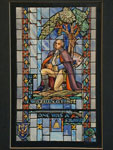BROWSE BY CATEGORY
- Archives and Libraries
- Blogs and Networking
- Bookmark This
- Digital Tools
- Examples of Teaching
- Exhibits
- Film Reviews
- History and Headlines
- Historic Sites and Museums
- Historical Thinking
- Holidays and Heritage
- Issues and Research
- Lesson Plans
- Material and Visual Culture
- Multimedia
- Organizations and Agencies
- Primary Sources
- Professional Development
- Publications
- Student Activities
- Teaching Materials
- Websites
Jennifer Orr on Teaching Heroes

Early elementary studies in history often focus on specific people. As students mature they are able to explore history over the course of periods of time and consider how certain events impacted other times and people. However, our youngest students do not have the necessary background knowledge and life experience to do so. As a result, early elementary history standards tend to be about individuals from the past.
My 1st graders study George Washington, Benjamin Franklin, Abraham Lincoln, and George Washington Carver, at least according to our state standards. My school district has added Eleanor Roosevelt to that list, one assumes in order to have at least one woman. The standard relates to U.S. leaders and their contributions to our country.
I don’t think anyone would argue that the above individuals contributed to our country. However, I do think there are concerns with this approach. While heroes taught in this way can be inspirational, I believe we are setting our students up for disappointment in those heroes when they find out they were, in fact, human. In addition, making them too heroic risks many students today finding them not inspirational but intimidating, or at least unrelated to their own lives.
I believe that one of the benefits of studying how individuals have contributed to our country is to show children the possibilities for their future. My students, however, will not see themselves in any of these people. The majority of these individuals lived in prosperous situations, at least as adults. We can study Franklin and Lincoln’s early years with limited financial resources, but they are still white men, and a log cabin doesn’t resonate with a child living in an apartment with two other families. Carver also rose from difficult circumstances, but they are circumstances that are very difficult for young children to understand. My students are mostly first-or second-generation immigrants. They speak another language at home. They will struggle to see similarities between their lives and the individuals we study.
Also, studying individuals through their contributions shows one side of them only. Washington and Franklin certainly did contribute significantly to the development of our country. However, the way they are presented to young children suggests a near perfection to these men, a lack of complexity. In a few years, when they learn more about them, these students will be shocked to learn that Washington owned slaves and that Franklin fathered an illegitimate child, whose mother’s identity is unknown. We teach about Lincoln’s rise from difficult financial circumstances to become president of the United States. Students learn that he abolished slavery. They see him as a savior for an entire group of people without recognizing the complexities of his views on race.
As we study these individuals in my 1st-grade classroom we create a data retrieval chart to which we can continually refer. It includes their names, the dates of their lives, their contributions, and other interesting facts. I include the other interesting facts for two reasons. The first is that my students are often fascinated by things that aren’t really contributions and we need a place for those. Second, this is a window of opportunity for me to highlight human aspects of these individuals. Through the resources we use to study these leaders—books, videos, websites—I can draw out interesting facts that might surprise my students. I can point out that George Washington was a slave owner and we can talk a bit about that. We can count how many elections Abraham Lincoln lost on his route to the presidency. We will list on our chart their contributions and many positive or neutral interesting facts, but I will attempt to ensure that the men and women we study are seen as people, people who gave much to our country but who were still human beings.
As teachers we have a responsibility to know more about the individuals we teach than the standards state. While the complexities of people may be more than young students can grasp, we can be more careful about how we present individuals. It is easy to glorify historical figures but we should present them as human beings and look at their achievements through that lens. That will help our students see the possibilities in all they have to offer.
For more information
How can you teach history as both individual and collective, mundane and heroic, organized and chaotic? Professor Linda Levstik says use history book sets that help students think about the actions available to people in history.
Our reprints of Journal of American History film reviews also model breaking down heroic narratives for the seeds of historical truth (check out the reviews of The Aviator and John Adams for looks at how film has simplified two historical figures to create compelling stories).
Monuments and memorials show whom people choose to remember as heroes and how they choose to remember them, according to high school teacher James Percoco in Using Primary Sources.
(And for a less realistic definition of "hero," Rwany Sibaja asks why not teach with superheroes?)
